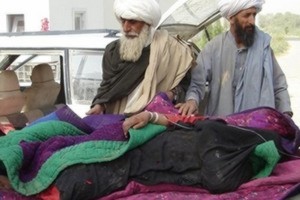By Thomas Harding, Defence Correspondent
The intensity of fighting in Afghanistan is laid bare today in new figures which reveal that almost four million bullets have been fired by British Forces in less than a year - almost double the number previously reported.
The number of rounds fired suggests that fighting in Helmand has been 'of much higher intensity'
The Ministry of Defence has been forced to admit it misled Parliament over the huge amount of ammunition used, after an accounting error.

The newly appointed district chief of Musa Qala, Mullah Abdul Salaam, center, shakes hand with a Britain military official, part of the International Security Assistant Force (ISAF) at a joint base of the ISAF and Afghan forces in Musa Qala district of Helmand province on Tuesday, Jan. 8, 2008. (AP Photo)
The Times, Jan.11, 2008: "According to senior British sources, he was implicated in the massacre of ethnic Hazaras and Uzbeks in Mazar-i-Sharif in 1998."
Opposition politicians said the revelation that almost four million rounds had been fired in Helmand province in less than a year told of fighting "of much higher intensity" than had previously been revealed.
The Tories said the figures, revealed by The Daily Telegraph today, contradicted Des Browne's statement to the Commons that the "security situation in Afghanistan is stable if fragile in places".
In October Bob Ainsworth, the Armed Forces minister, told MPs that 2.7?million rounds had been used in Helmand.
advertisementBut the information was wrong and in a letter to Liam Fox, the shadow defence secretary, he apologised for the mistake, explaining that it had "now become apparent" that the ammunition originally counted was of the "most common types" and did not include other varieties such as tracer rounds.
Many weapons can take a variety of bullets. There are seven types of round for the 5.56mm calibre SA80 rifles, and five for the typical 7.62mm machine gun. Similarly, 105mm artillery ammunition has 11 varieties, including high explosive, smoke and illumination. Mr Ainsworth admitted his original answer had included only one type of 7.62mm, two types of 5.56mm and "some" of the 105mm variants.
Writing to Dr Fox he said: "Please accept my apologies for this mistake. Since answering your question work has been undertaken in theatre to improve and simplify record keeping."
He was also forced to admit that the figures could even be higher as they only began in mid-August 2006 and not June that year, when fierce fighting began between the Parachute Regiment and Taliban forces.
Dr Fox said: "These new figures illustrate the intensity of fighting our troops face. It does call into question Des Browne's judgment that the Taliban poses no strategic threat to the Government of Afghanistan."
He added that it further undermined the former defence secretary John Reid's aspiration that British Forces would leave Afghanistan "without a single shot being fired."

IWPR, December 11, 2007: Residents of a southern village tell of a night of violence at the hands of foreign and Afghan soldiers. “They killed civilians - people like me - with rough farmers’ hands. If you don’t believe me, then come with me to the cemetery. I will dig up the bodies to show you.”
Photo Gallery of US victims in Afghanistan
The Afghan Victim Memorial Project by Prof. Marc
The mistake comes after the public was also misinformed by the Prime Minister that no talks were being held with the Taliban.
In fact, as The Daily Telegraph revealed last month, MI6 officers have on more than half a dozen occasions met Taliban leaders over the summer. Since the story appeared at least one Taliban commander, Mansoor Dadullah, has been disciplined by the leadership.
The 25,000 artillery rounds used compare to 6,000 used by British forces during the 2003 invasion of Iraq.
During the most intensive period of urban fighting witnessed in Basra last summer, 4 Rifles, the battalion based in Basra Palace, fired 35,000 rounds of small arms - the amount used in three days by the 7,800 British troops in Afghanistan.
Col Tim Collins, who commanded an infantry battalion in Iraq, said the expenditure of ammunition reflected the fact that the system was "running white hot" to keep up with the pace of operations in Afghanistan.
"I don't think the Government deliberately lied but it was being economical with the truth not to reveal the ferocity of operations going on which it tried to avoid with the earlier Commons answer."
He added the huge number of rounds used showed the extreme pressure the logistics tail was under in getting bullets to the front line.
The MoD said much of the error was caused by a failure to include training and blank rounds used by troops around Camp Bastion to practise their "fire and manoeuvre" skills.
It is not known whether the figures will mean that the operation in Helmand is costing more than the £1?billion-a-year current estimate.
Rounds used
Aug 2006 - Sept 2007
SA80 (5.56mm)
Original report: 1,100,000
Actual number: 2,020,000
General Purpose Machine Gun (7.62mm)
Original report: 1,600,000
Actual number: 1,830,000
Artillery (105mm) Original report: 12,000
Actual number: 25,000



